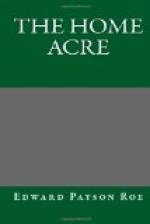Under any circumstances this tendency to produce an undue amount of wood must be repressed almost as rigorously as in the grape-vine. The secret of successful currant-culture is richness beneath, and restriction above. English gardeners are said to have as complete and minute systems of pruning and training currants as the grape; but we do not seem to have patience for such detail. Nor do I regard it as necessary. Our object is an abundant supply of excellent fruit; and this result can be obtained at a surprisingly small outlay of time and money, if they are expended judiciously.
The art of trimming a currant-bush, like that of pruning a grape-vine, is best learned by observation and experience. One can give principles rather than lay down rules. Like the vine, the currant tends to choke itself with a superabundance of wood, which soon becomes more or less barren. This is truer of some varieties than of others; but in all instances the judicious use of the pruning-knife doubles the yield. In view of the supposition that the leading shoot and all the branches were shortened in one-half when the plant was set out, I will suggest that early in June it will be observed that much more wood is forming than can be permitted to remain. There are weak, crowding shoots which never can be of any use. If these are cut out at this time, the sap which would go to mature them will be directed into the valuable parts of the forming bush. Summer pruning prevents misspent force, and it may be kept up with great advantage from year to year. This is rarely done, however; therefore early in spring the bushes must receive a good annual pruning, and the long shoots and branches be cut well back, so as to prevent naked reaches of wood. Observe a very productive bush, and you will see that there are many points abounding in little side-branches. It is upon these that the fruit is chiefly borne. A bush left to itself is soon a mass of long, slender, almost naked stalks, with a little fruit at the ends. The ideal bush is stocky, open, well branched, admitting light, air, and sun in every part. There is no crowding and smothering of the fruit by the foliage. But few clusters are borne on very young wood, and when this grows old and black, the clusters are small. Therefore new wood should always be coming on and kept well cut back, so as to form joints and side-branches; and as other parts grow old and feeble they should be cut out. Observation and experience will teach the gardener more than all the rules that could be written, for he will perceive that he must prune each bush according to its own individuality.




